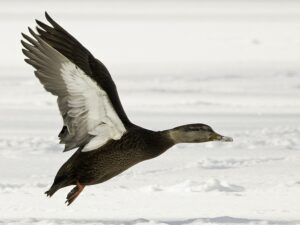- American Black Duck
- Anas rubripes
- French: Canard noir
 This large dabbling duck breeds in a variety of North American wetlands, including freshwater wetlands created by beaver; brooks lined by speckled alder; lakes, ponds, and bogs throughout mixed hardwood and boreal forests; and salt marshes. Postmolting males, females , and fledged young assemble near breeding areas in early September. Southward movements of migrants begin in September to early October, depending on latitude, and individuals travel overland or follow major rivers and the Atlantic Coast to reach wintering sites in coastal marshes from Nova Scotia to the mid-Atlantic states. Migrants eat seeds, foliage, and tubers of aquatic plants and seeds and fruits of terrestrial species, a variety of invertebrates, agricultural grains, and occasionally fish and amphibians.
This large dabbling duck breeds in a variety of North American wetlands, including freshwater wetlands created by beaver; brooks lined by speckled alder; lakes, ponds, and bogs throughout mixed hardwood and boreal forests; and salt marshes. Postmolting males, females , and fledged young assemble near breeding areas in early September. Southward movements of migrants begin in September to early October, depending on latitude, and individuals travel overland or follow major rivers and the Atlantic Coast to reach wintering sites in coastal marshes from Nova Scotia to the mid-Atlantic states. Migrants eat seeds, foliage, and tubers of aquatic plants and seeds and fruits of terrestrial species, a variety of invertebrates, agricultural grains, and occasionally fish and amphibians.
This duck begins nesting in February in southern parts of its range, but often not until late May in northern parts. Most pairs form or reform, pair bonds annually in winter, many by December. Once on the breeding grounds, males defend territories until their mates reach mid-incubation. Nest sites are abundant and variable, and nests usually are well concealed and on the ground, often in uplands. Only females incubate. Once the ducklings hatch females lead broods to rearing areas where abundant invertebrates and vegetative cover can be found.
Distinguishing Characteristics
The American Black Duck is a large, dark-brown dabbling duck.
Both male and female have uniformly blackish-brownish body-feathers with a paler neck and head, and dark crown, nape and eye-stripe. The bill of the male is olive green to yellow, while that of the female is a greenish gray with blackish markings. Legs and feet are reddish orange. Wings are dark brown above with an iridescent, violet speculum that is narrowly bordered with white on trailing edge and black on leading edge. It is the only regularly occurring North American duck to show bright white underwings while in flight.
The American Black Duck has the darkest plumage, and least amount of white on upperwing than several similar species or forms with which it might be confused, including Mottled Duck, eclipse Mallard, and Mexican Duck. The American Black Duck is closely related to, and most often confused with, the female Mallard. Black duck and mallard hybrids can also be mistakenly identified as black ducks.
Immatures resemble adults of their sex, but they appear more heavily streaked on breast and their feet are more brownish than the adults.
Vocal Identification
Sound byte
Vocalizations of American Black Duck are considered calls not songs; similar to those of Mallards.
Male: Most common call is a reedy raeb or raeb-raeb.
Female: Familiar loud quack is most common, but also gives other calls.
Breeding Range:
Canada: Breeds along Hudson Bay in northeast Manitoba; throughout Ontario; throughout Quebec, except on Ungava Peninsula, and throughout Labrador except in Torngat and Kaumajet Mountain ranges, but along coast north to Hebron; on Anticosti Island and Magdalen Islands, and throughout New Brunswick, Nova Scotia, Prince Edward Island, and Newfoundland.
United States: Breeds from Canadian border south to northeast Minnesota; northern Wisconsin; southern Michigan and northern Ohio; northeast West Virginia; Maryland and Delaware; and along coastal plains of Virginia and North Carolina. Breeds locally and irregularly in western and southern Minnesota, northeastern Illinois, central Indiana, and southwestern West Virginia.
Winter Range: Winters mainly from southern portion of breeding range south to Gulf Coast and northern half of Florida. Northern limits of main range extend to southeastern Minnesota, central Wisconsin, eastern Upper Peninsula of Michigan, southern Ontario, extreme southeastern Quebec, northern New Hampshire, coastal portions of Maine and New Brunswick, Prince Edward Island, Nova Scotia, and coastal portions of central and southern Newfoundland. Winters south along Atlantic Coast to northern half of Florida Peninsula, Gulf Coast of Florida, Alabama, and Mississippi. Winters west to eastern Iowa, north and eastern Missouri.
Migration
Partial short-distance migrant confined almost entirely to North America. Annual migration between nesting and wintering areas is documented by band recoveries; distance migrated is related to latitude of nesting. Routes of migration are indistinct and corridors loosely defined because of short distances moved by some birds and overlapping breeding and wintering ranges.
Both sexes migrate at night, moving in small flocks (12-30). Flocks linger if undisturbed by hunters in fall, especially along coastal corridors until weather worsens or foods are diminished. In spring, birds congregate in open water of coastal areas adjacent to natal breeding areas, then move to first open water on inlands wetlands
Source: Longcore, J.R., D. G. McAuley, G.R. Hepp, and J.K. Rhymer. 2000. American Black Duck. In the Birds of North America, No. 481.

